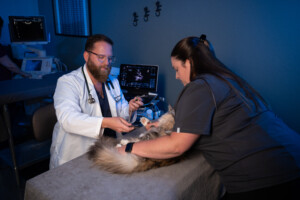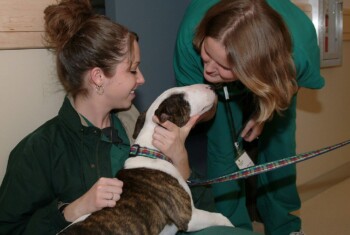What are episodes and lookalikes?
There are many types of neurological episodes that can occur in dogs and cats. In some cases, their appearance can be quite similar and difficult to distinguish, earning them the name ‘lookalikes.’
Some common neurological episodes in dogs and cats that can easily be confused with each other include:
- Seizures
- Dyskinesia (abnormal, involuntary body movements)
- Syncope (fainting or collapse) (this is technically a non-neurological episode)
- Vertigo (vestibular disorders)
- Narcolepsy/cataplexy
- Tremors
What to do if a pet is having a neurological episode
If your pet is having a neurological episode, the first thing to remember is to try to remain calm. This can be difficult when your beloved pet appears to be in distress, but most episodes are not life-threatening, and if the event is serious, there is very little you can do at home to change the outcome. It is best to remain calm and help soothe your pet when the episode stops.
During the episode, keep your hands away from your pet’s mouth to avoid being inadvertently bitten. It is not possible for a pet to swallow their tongue, so there is no reason to have your hands near their mouth.
If your pet is near stairs or furniture where they may fall or hit their head, carefully slide them away from danger.
If the episode lasts longer than 2 minutes, start heading towards the nearest emergency veterinary clinic for assistance just in case intervention is necessary. In many cases, episodes are self-limiting and do not require immediate intervention, but this is not always easy to determine at first.
If safe to do so, attempt to get a video of the episode so your veterinarian can better help characterize the type of neurologic episode.
Clinical signs and symptoms of neurological episodes in dogs and cats
Your veterinarian’s primary goal when a pet has intermittent episodes is to try to determine whether the episode is related to a certain part of the brain. Try your best to note the following characteristics:
- Was your pet aware of their surroundings during the episode? Could they orient to the sound of your voice, look at you, look at a squeaky toy?
- Were they trying to stand or walk during the episode, or were they lying on their side?
- Were their limbs tense or relaxed? Which limbs were affected (one limb, one side of their body, all four limbs)?
- Was there excessive salivation?
- What were they doing when the episode started (relaxing, running or playing, eating or about to be fed)?
- Did the episode have a discreet start or end? When it was over, were they normal right away, or still impaired for some time?
- Did you notice any abnormal eye movements during the episode (e.g., with the actual globe of the eye jerking side to side)?
The more details you can give your vet, the more information they will have to help identify the part of the brain the episode was related to.
Causes of neurologic episodes
There are two phases of the diagnostic approach to consider:
- What type of episode is occurring?
- What is the underlying cause of the episodes?
Episodes may be considered “idiopathic” (e.g., no specific cause, no progressive disease present) or there may be an underlying disease causing them.
Common causes of episodes include:
- Metabolic abnormalities (e.g., disorders of the liver, kidneys, or other important enzyme pathways in the body)
- Endocrine disorders (e.g., thyroid disorders, low or high adrenal function, diabetes)
- Brain inflammation (e.g., infections, autoimmune inflammation)
- Brain tumors
- Strokes
- Degenerative or congenital brain diseases
- Cardiac (heart) abnormalities (e.g., irregular heart rhythms (arrhythmias), unusually fast or slow heart rates)
- Environmental triggers (e.g., stress, toxins, trauma)
Getting a diagnosis
Because the nervous system is so hidden away from view, and because the clinical signs overlap considerably between these various body systems (the heart, brain, etc.), the diagnostic testing plan may be a series of tests. The order in which these tests are done depends on the suspected cause and is important to ensure patient safety.
Depending on the specific characteristics of the episodes and any clues from your pet’s physical examination, the next step may be a cardiac evaluation such as an echocardiogram or electrocardiogram. If the cardiac scan is not necessary or is performed with inconclusive results, then the next likely recommendation is evaluating the brain and nervous system with an MRI or spinal tap.

Echocardiogram (echo) and electrocardiogram (EKG/ECG)
In some cases, a cardiac evaluation may be recommended prior to any other tests. This is often because, if the episodes are cardiac in nature, there may be specific safety measures required when performing general anesthesia.
Since general anesthesia is required for specialized neurological tests (such as an MRI and spinal tap), this cardiac evaluation can be very helpful and important as a first step and screening test. A veterinary cardiologist can evaluate if the episodes are due to a heart arrhythmia, and can make recommendations as to whether any adjustments need to be made to the anesthesia protocols to keep your pet safe.
A heart evaluation may involve:
- Ultrasound of the heart (echocardiogram) to look at the structure and function of the heart
- Electrocardiogram (EKG or ECG) to look at the rhythm and rate of the heart
- Holter monitor (also called event monitor), in some cases, to monitor the heart rate and rhythm during the episodes over 24 hours, or several weeks
If there is a cardiac cause, your cardiologist can recommend appropriate treatment. If these tests are unremarkable, then a cardiac cause of the episodes is considered less likely.
MRI (magnetic resonance imaging)
The brain is another common source of episodes. An MRI scan allows us to see the tissues of the brain in great detail.
An MRI scan takes about an hour to perform. During that time, your vet will use different settings to highlight various characteristics of the brain tissue. Some settings are better for showing tissue while others show fluid, inflammation, hemorrhage or ischemia (e.g., strokes).
These images are captured again after the patient is given an intravenous contrast agent. Contrast agents show up bright white on the MRI scan and are used to highlight tumors and inflammation.
An MRI can help determine if the cause of episodes is due to a structural problem of the brain (such as a stroke or tumor) or a deep ear infection (which could affect the vestibular system). If the MRI is normal, then these are not likely the cause of the episodes.
Spinal fluid analysis (spinal tap, CSF tap)
A spinal fluid analysis can show if there is any inflammation or infection in the brain that may be causing episodes.
Despite a spinal tap being important for a diagnosis, an MRI is performed first in most cases because it can help determine if a spinal tap is safe to perform. If significant brain swelling is present, this can cause pressure in the brain, and performing a spinal tap when there’s increased pressure in the brain can be very dangerous and potentially even fatal.
Specialized blood tests
Where appropriate, your veterinarian may recommend specialized blood tests to screen for things like:
- Thyroid problems
- Adrenal gland problems
- Diabetes
- Liver diseases
In some cases, DNA tests may be used to check for specific inherited diseases.
What if all of these tests are normal?
If the diagnostic tests are normal, then the cause is likely “idiopathic,” which means there is no underlying pathologic cause. The episodes are likely innocent and would be treated as a symptom, without concern for an underlying disease.
This may include treatment for:
- Seizures
- Vertigo
- Dyskinesia
- Narcolepsy
- Other symptoms as appropriate
There are typically a number of treatment options for managing episodes as a symptom.
Questions for your doctor
 When consulting with your pet’s veterinarian, consider asking questions like:
When consulting with your pet’s veterinarian, consider asking questions like:
- What are the treatment options for these episodes, and the associated risks and costs for each option?
- What are the predicted outcomes for this type of episode? What is a realistic expectation for control?
- Under what circumstances should I seek emergency care for these episodes?
Treatment
If an underlying disease is identified, then specific treatment for that condition will be discussed and recommended.
In most cases, symptomatic treatment to minimize the occurrence of episodes will be recommended regardless of whether an underlying disease is present or not.
The treatment for the various types of episodes depends on the type of episode occurring. That is to say, the medications used to effectively treat seizures are not effective for dyskinesias or narcolepsy, and vice versa.
Prevention
In some cases, episode triggers may be identified and avoided.
In most cases, there is no clear trigger to avoid.
If you feel that there is a reliable trigger for your pet’s episodes, please bring this to your veterinarian’s attention so it can be discussed in more detail.
Prognosis
The prognosis for neurological episodes is very dependent on the specific type of episode that is occurring, and the underlying cause.
For idiopathic episodes, it is reasonable to expect some amount of control with medications. It is not typical for episodes to be stopped entirely, and some breakthrough episodes are likely to occur.
For episodes caused by underlying disease, the prognosis is likely dependent on the specific disease present.
Many BluePearl Pet Hospitals offer advanced diagnostic equipment and specialty veterinary services including neurology. Find a BluePearl neurologist near you.


